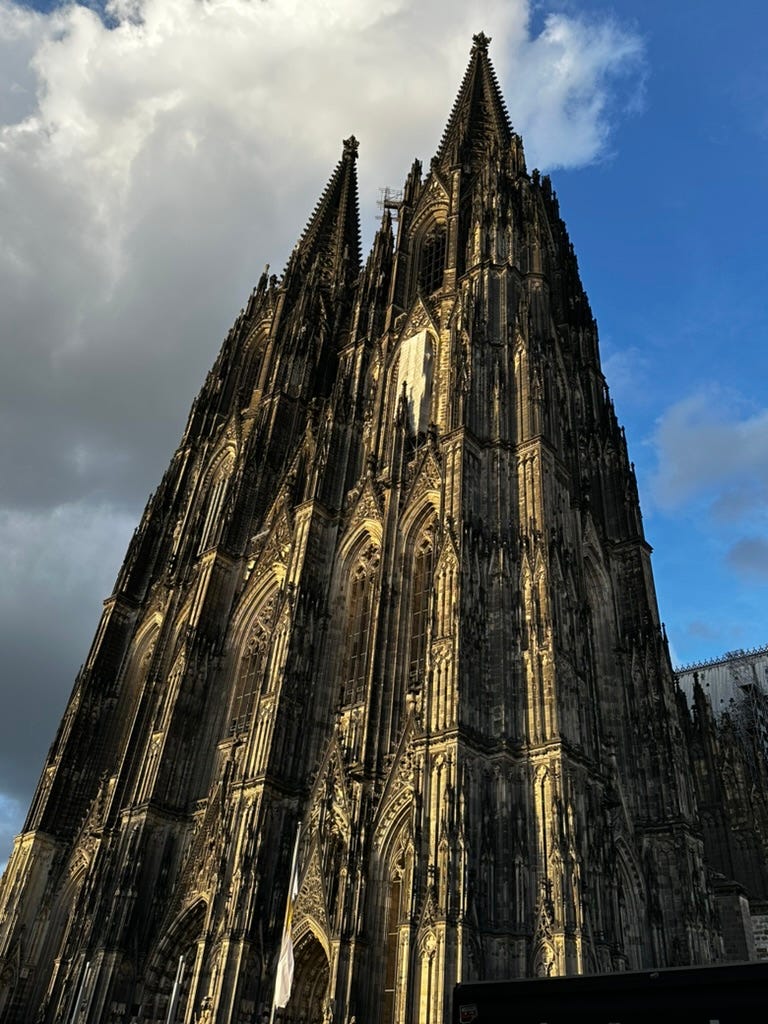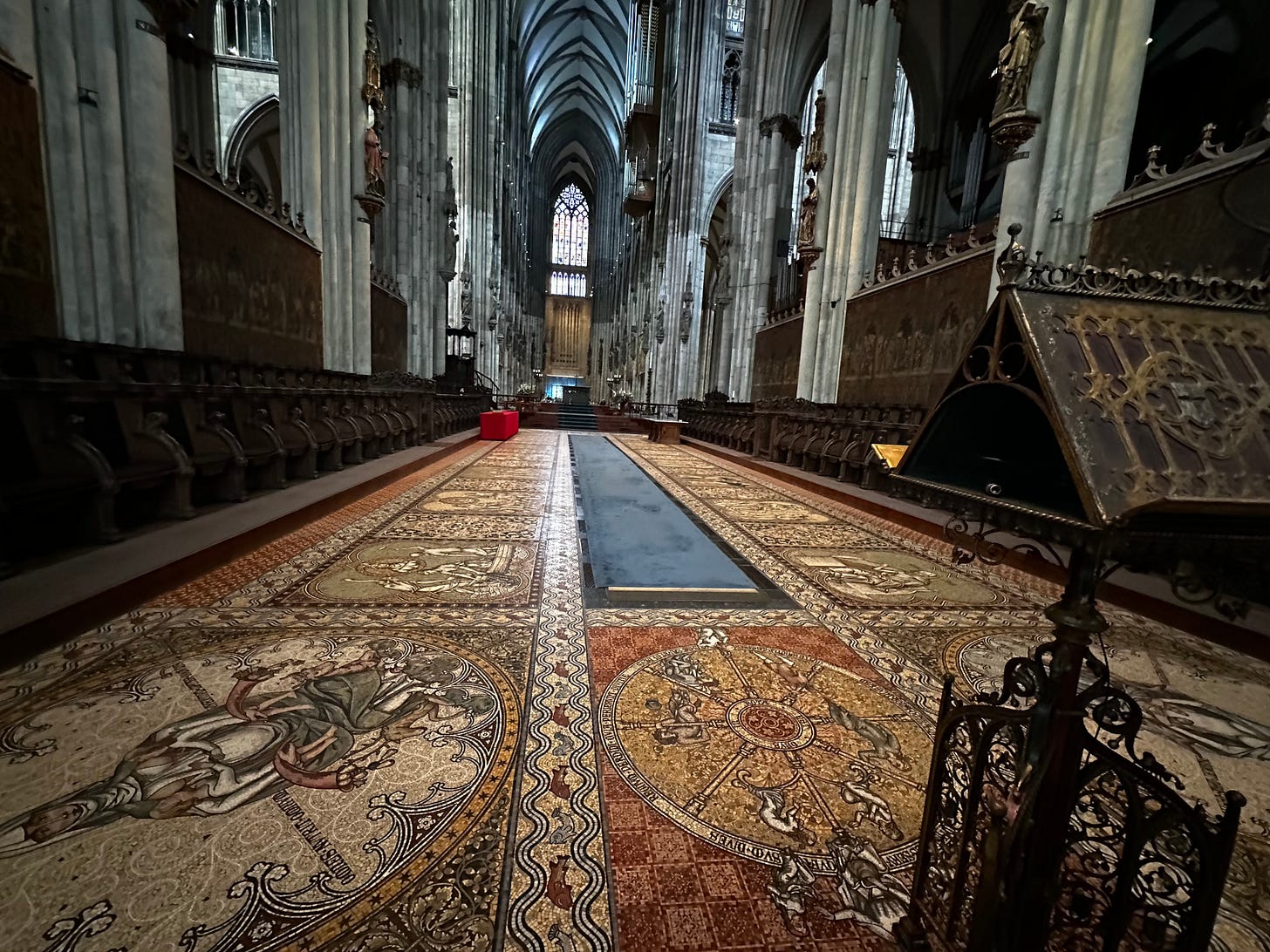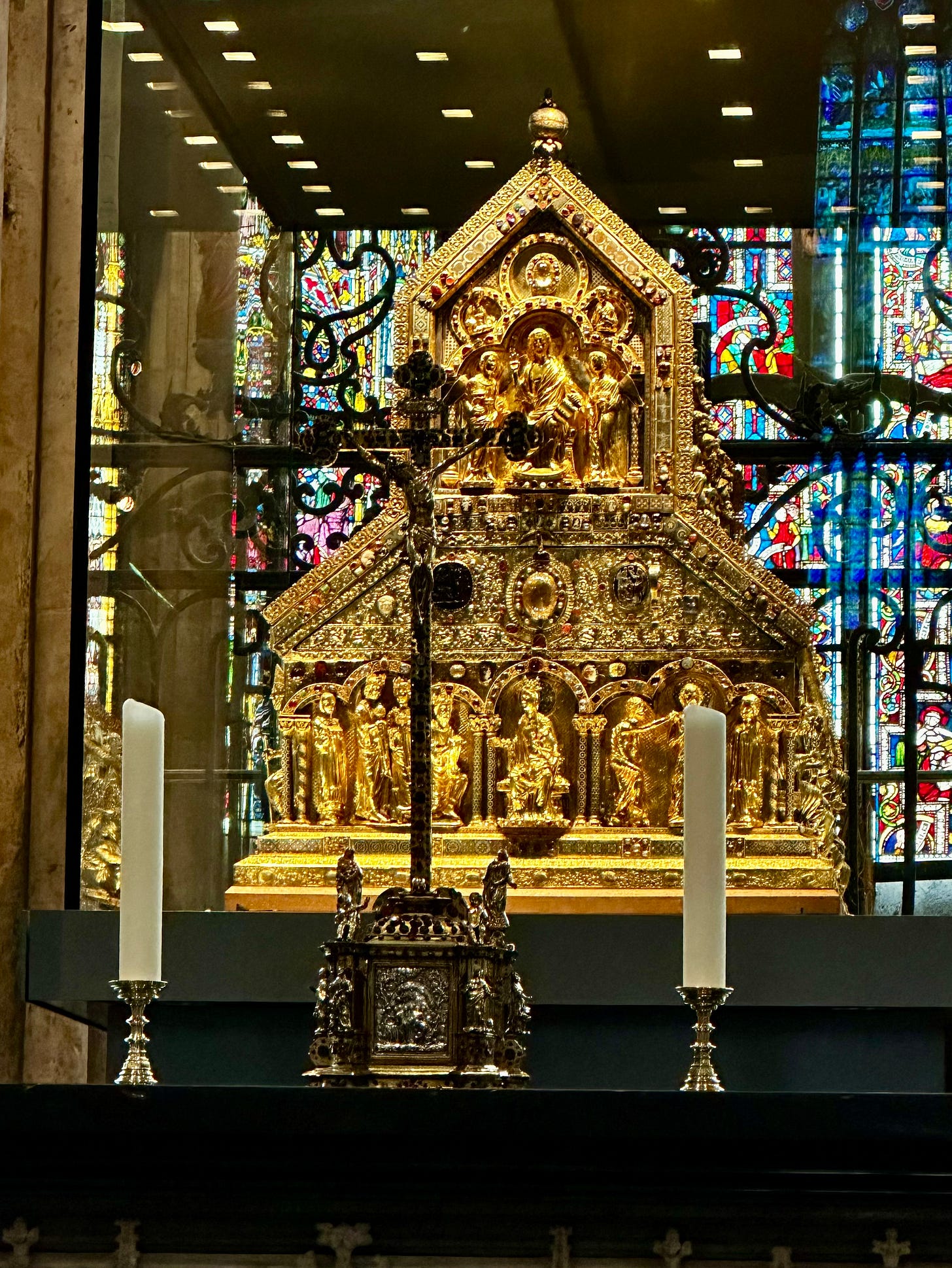How I Met the Three Wise Men
A contemplation of the quintessential pilgrims

From my first pilgrimage to the Balkans, we ended the trip by flying out of Amsterdam which required a train ride across the entirety of Germany. We took the night train from Vienna to Amsterdam, and I slept horribly on the hardest, most uncomfortable situation—to call it a mattress would be stretching the truth. I woke from sleep (if you can call it that) at sunrise, just as the train was passing by Cologne cathedral, and my bleary eyes saw the morning rays illuminating this immense bastion of human architectural achievement—to call it a building seems crass—but the words “That is the most beautiful building I’ve ever seen” flashed through my sleepy head. I knew it was Cologne Cathedral, from pictures. After it passed by in the early morning light and the view returned to clumps of trees interspersed with nondescript landscape whizzing by, I settled my aching back against the slab and tried to sleep a little more. Nevertheless in that short interaction with Cologne cathedral, I had added a significant item to my “bucket list” and determined that I would need to return and see this marvel of architecture in person.
When I saw that the advertised Orthodox Tours itinerary included Cologne and the trip coincided with a visit to see my offspring, the logical conclusion was to sign up.
I can hardly begin to wrap my head around this place, and I suppose that is where the pilgrimage begins. When I am confronted with something that is so huge, expansive, glorious, and incomprehensible, I am forced to make a journey into a form of understanding that takes me outside of myself and brings me into something— or rather Someone—greater.

It is hard to speak about the scale of this Cathedral (a UNESCO world heritage site) without waxing technical and venturing into areas of architecture and engineering in which I have no expertise.1 One could not describe this cathedral as being human scale. Of all the churches that we entered on this pilgrimage, and there were many, I would not necessarily call it my favorite, for there were many that were more accessible, or more friendly. However, it was by far one of the most awe-inspiring man-made structures I have ever encountered, and that is, of course, the point. One would be remiss to call the first sighting of this imposing structure a “glimpse” as it requires all of one’s brain to take it in—it is just so massive. As I entered the portal I caught my breath—nothing I had seen until that moment could compare with or surpass the encounter with this masterpiece. It had, in an instant, become the benchmark to which all other Cathedrals and works of architecture in general would be compared. At the time of its completion, after a long 600 years, Cologne Cathedral was the tallest building in the world and remained so for four years, surpassed by (of all things) the Washington Monument, arguably one of the worst memorials ever to be erected, pun intended. Cologne Cathedral remains the tallest twin-spired Cathedral to this day, and the third tallest church of any kind in the world.2 The story of Cologne is one of empires, kings, bishops, conquerors, Saints, protest, war, reconstruction, and pilgrimage, and the history of this Church tells the story in its bones and windows. But why? What is the purpose of this massive expenditure of resources and labor? We in the West are so frequently challenged by our Protestant paradigm to appreciate or honor such displays of grandeur and judge them as misappropriations of worship. We have been taught that simplicity, and even plainness is a more apt expression of piety. The Orthodox and Roman Catholics of the world disagree, and we Protestant Westerners have sold ourselves short by this mindset.

The short answer for why it was built was to house the bones of men long dead, but not just any men—the Cathedral was commissioned to house the relics of the three magi who followed a star from the East to worship God incarnate upon the lap of his virgin mother, the Holy Theotokos. On that day in that cathedral I stood feet away from their relics and prayed. It occurs to me that they were the first pilgrims of the Christian era, searching for something and not fully knowing the implications of their their journey when they set out.
Inside the jewel-studded golden box rest the bones of three men known as magicians or “wise men” who traveled “from the east” to find the Christ child (Matt. 2). It all sounds so strange and utterly foreign to us and the fact that they were even known as “magi” (magician) immediately conjures visions of Harry Potter / Lord of the Rings / Fantasia images in our poor little materialist brains. Nevertheless, the tradition pointing to the authenticity of these relics is ultimately a matter of faith. The Orthodox and Roman Catholic accounts of the history of the Three Wise Men dovetail, but oral tradition is all there is to “prove” their authenticity. While most Western sources have a tone that tells a story as legend, the Eastern telling more often seems to take a story at face value, with a higher degree of trust in oral tradition, not looking exclusively to documentation as proof of a thing. With regard to these particular bones, we simply cannot be sure, but the sincere faith of the pilgrims who venerate them have make them holy.
Certainly it was a lucrative thing to be in possession of valuable relics and the acquisition of these particular bones by the Bishop of Cologne was certainly a part of the motivation to relieve Milan of them as part of the spoils of war.3 Once in possession, the only fitting thing to do was to build a Cathedral fit for kings in order to ensure that they would indefinitely remain part of the legacy and wealth of Cologne and this seat of worldly power. A proper box would be necessary as well, and the Golden reliquary was commissioned—one of the finest in the world.
As I encounter this memory again through photos and recollections of the experience, I cannot help but wonder what spiritual strength resides there? The magi were guided by the God they were about to encounter, who existed before them, who created and knew them, and yet these men, now reposed, stood face to face with that same God as a very young human child, perhaps held him in their arms and made silly faces at him to make him laugh. Spoke with his mother. Wondered at the story of his conception and birth. In the time spent there, they became convinced of his Kingship and the promise of his birth, so much so that they changed direction and went home another way to avoid Herod’s sinister need for information about the child. But upon their decision to return, they were changed. They had new understanding, and they had a responsibility to protect that knowledge.
As a pilgrim, both “accidental” and intentional, I am never sure when I set out on a journey what kind of change will result from the experience. Like the wise men who set out pursuing a star, unaware of the implications of their undertaking, pilgrims embark on their journeys to that end—to encounter the God they cannot comprehend, and return changed. They are in search of some luck, an answer to prayer, to change their fortune, to pay a penance, to show gratitude, to seek healing, or to find answers. Anyone who goes on a pilgrimage with a goal in mind will return with that objective met or unmet, but they will have some new understanding of themselves and how God guides them. They may come home with a new insight about Him that they never imagined would find them.
Four of us pilgrims would do a small debrief together at the end of every day of travel. It was called “High, Low, Buffalo” and it was a targeted conversation in which we pointed out the high point of the day (things we had seen and encountered, meals we ate, people we talked to), the low point of the day (getting soaked in a storm, allergy attacks, enduring an overly-long explanation of a sculpture that we hated), and a “buffalo.” A buffalo was an unexpected thing that added depth, color, or richness to the experience of the day. It could have been anything, but usually was something small—a particular enlightening conversation, some meaningful treasure found in a museum, a moment alone that was particularly rich, or the visitation of a Saint’s blessing along the way.
If I were to play “High, Low, Buffalo” after the trip and identify these moments, I have to mark the moment I walked through the portal of Cologne Cathedral into the nave of the church for the first time as the high of the trip. This was not entirely unexpected. This breathtaking experience was the kind of moment that we humans live and plan for, in hopes of experiencing that rush of emotions that sear memories onto the hard drives of our minds. What I was not prepared for was the “buffalo” that would come as a result of this encounter with the relics of the Three Wise Men. When I say that, I mean that I knew this was part of the Cologne experience and that millions of pilgrims and tourists before me had visited this site and taken in the form of the reliquary and read the blurbs about the men inside, maybe prayed a prayer, and walked out with a pilgrim stamp in their pilgrim passport and snapped photos if they were living in such a time as to make that possible. I expected to be no different because going in, I had not invested any amount of confidence into the idea that these relics were authentic or much more than a tourist attraction to bring revenue into the Archdiocese of Cologne. Yes, I could be accused of being a skeptic.
Yet an incredible thing has happened…The Wise Men from the East became much more to me than a Christmas story or a Protestant sermon or a liturgy celebrated by the Catholic Church. The reality of them has taken root in my own consciousness. Their patient work of contemplation and discernment, translating into bold acts of faith, causing them to leave their known country to find something that they could not have understood, that would change the course of all humanity and its interaction with the God of the universe has wrecked me.
In the beginning of the story of redemption, Abraham was called by God to leave his country and travel to a land that was promised to him and he responded in faith and God counted it to him as righteousness (Gal. 3:6). God had Abraham look to the stars and in that interaction made the promise that his descendants would be as the stars of heaven. His descendants are all who respond to God in faith. Though Christ would come through the Hebrew people, through the kingly line of Judah, it was through Abrahamic covenant that he was promised to all the world. All who hear the word of God and believe and act accordingly are Abraham’s offspring. It is not merely an ethnic group or nation-state of people (though certainly there are righteous ones among those physically descended from Abraham), but all who have been grafted in are his descendants in equal measure (Romans 11:17-24). God, in fulfilling his promise to the world did not rely on human messengers or wait for a proper religion to form. It seems that the holy God of the Universe, in his delight at the birth of his son, could not wait to tell the news to the whole world, so he wrote it in the stars. He called men from a foreign country to come and see, to believe, and to be changed, thereby identifying Christ as being for everyone, everywhere, no matter who they are. The magi had to wait—they did not see the result of their journey, or even of the devastation that their journey would unleash, costing the lives of countless child-martyrs at the hands of a foiled Herod. They simply believed God, followed the star, and encountered Christ. Had they known of this devastating part of the story, would they have gone at all? In their lifetimes, they would never see that outcome, nor the fullness of the Church in the world, nor the role they had played in bringing it about. Even so, God saw fit to write them into the story of His redemption of the World and make them and their very bones some of the first to proclaim his majesty (Matthew 2:1-18).
For an absolutely delightful rendering of the history and story of the three magi and their relics, watch this:


Beautiful Kelly. Thank you.
Do you know if they are planning another German trip in next couple of years? The wife thinks Greece is far better for a orthodox pilgramage but I have always been more interested in German politics / history / food so combining both angles would be attractive.